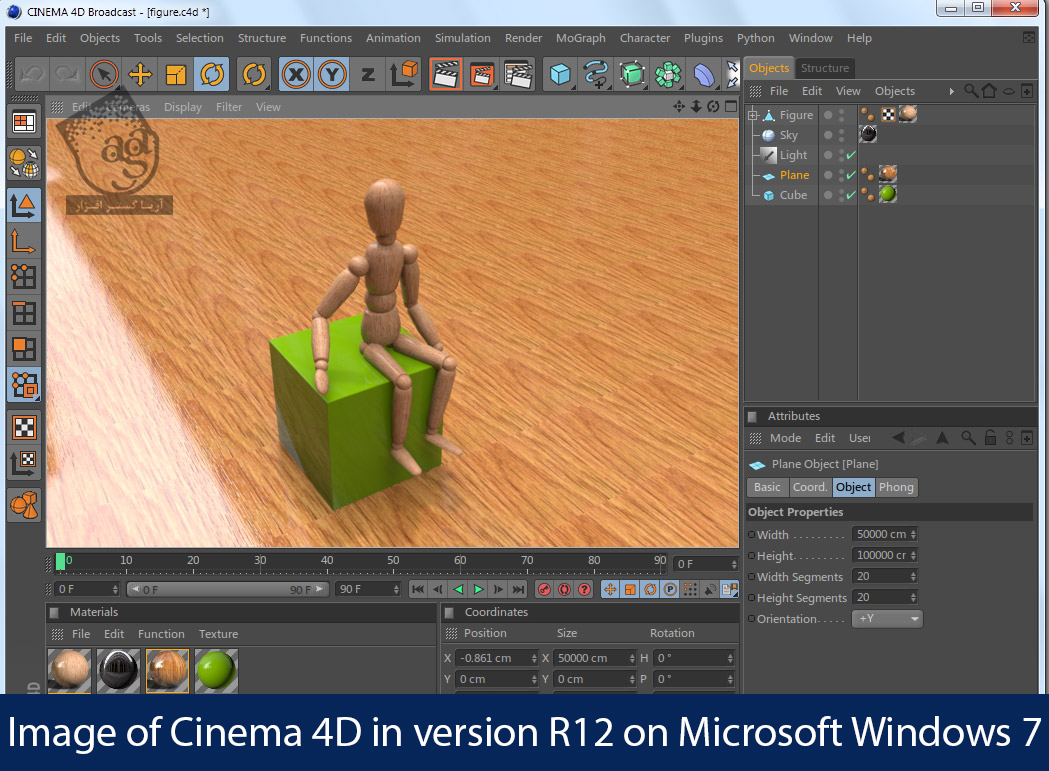


What is Cinema 4D : Introducing Cinema 4D software : In this video, we will introduce Cinema 4D software and see what Cinema 4D is in general and what applications it can be used for. In this video, which also comes with Persian subtitles, you will understand why Cinema 4D is the simplest 3D software for high-level professional work. You will get acquainted with the applications of this program, you will see the different work done in different industries with this software, and you will better understand how much you can give life to your creativity and ideas with this tool.
Cinema 4D is a modeling, animation and rendering program developed by MAXON Computer GmbH in Germany. This program has the capability of procedural and polygonal / subd modeling, animation, lighting, texture creation, rendering and common features of 3D modeling programs.
What is Cinema 4D ? The MAXON cinema 4d logo features four models of the Cinema 4D program: an original Cinema 4D ‘Prime’ program, a ‘Broadcast’ version with additional motion graphics features, a ‘Visualize’ version that offers architectural design capabilities, and a ‘ Studio ‘which includes all of these things.
In 2014, the fifth Cinema 4D model, “lite”, was released, which came with Adobe After Effects Creative Cloud 2014, and acts as an introductory version, and many of its features have not been released. This is part of a new collaboration between the two companies that a new MAXON plugin called CINEWARE allows all of these models to create a smooth Workflow with After Effects. The “Lite” model is affiliated with After Effects CC and requires the latest software to run, and is only sold as a component with Adobe After Effects CC 2014.
What is Cinema 4D was first developed for Amiga computers in the early 1990s, and the first three versions of the program were released for that platform only. But in version 4, MAXON also introduced the program for Windows and Macintosh computers due to its growing audience and the growing instability of the Amiga PC market due to the bankruptcy of Commodore.

What is Cinema 4D ? The Cinema 4D had a modular approach until version 11.5, expanding the main program with different units. This issue ended in version 12, although the capabilities of these units remain in different Cinema 4D models (Prime, Broadcast, Visualize, Studio). Older units included the following:
– Advanced Render (global illumination / HDRI, caustics, ambient occlusion and sky simulation)
– BodyPaint 3D (direct painting on UVW Mesh that is now in the main program. In fact, Cinema 4D Core / Prime and BodyPaint 3D products are the same. The only difference between the two is the splash screen that is displayed at runtime and the interface Default user.)
– Dynamics (to simulate soft body and rigid body dynamics)
– Hair (simulation of hair, fur, grass, etc.)
– MOCCA (character animation and costume simulation)
– MoGraph (procedural modeling of motion graphics and animation tools)
– NET Render (for rendering animations on a TCP / IP network in rendering farms)
– PyroCluster (simulation of smoke and fire effects)
– In CINEMA 4D R10, the PyroCluster unit was integrated with the Advanced Render unit.
– Sketch & Toon (tools for cel shading, cartoons and technical drawings)
– Thinking Particles (enabled particle system based on Nodes)
– Xpresso (has never been a unit and is a central feature)
– From version 13 onwards, Cinema 4D will be released in four parts:
– Prime (Central Program)
– Broadcast (MoGraph2 added to it)
– Visualize (Virtual Walkthrough, Advanced Render, Sky, Sketch and Toon, data exchange and camera matching added)
– Studio (complete package)
Cinema 4D sub-rendering engines
Since 2014, these rendering engines and sub-engines have been available as plugins for Cinema 4D.
– finalRender stage 2.0 SP4 from Cebas Computer GmbH
– FurryBall graphics card rendering
– FryRender from RandomControl
– Indigo Renderer, a realistic unbiased renderer
– Krakatoa from Thinkbox Software
– Maxwell Render from Next Limit Technologies
– mental ray & iray from at² GmbH
– Octane Render, an unbiased renderer accelerated by oToy GPU
– Pixar Renderman Connection Cineman from MAXON Computer GmbH
– SunFlow
– V-ray (Vray4C4D)
– Corona Renderer
– Arnold Renderer (C4DtoA)
History of Cinema 4D Versions
1990
– Kristin and Philip Loach registered their Ray Tracer in Kickstart Magazine’s monthly programming contest and won the contest.
1991
– FastRay (original name CINEMA 4D) was released for the Amiga computer.
1993
– CINEMA 4D V1 was released for Amiga PC.
1994
– CINEMA 4D V1.5 and V2 release for Amiga PC.
1995
– Release of CINEMA 4D V2.1 and V3.0 for Amiga PC.
– The plan to release CINEMA 4D to the PC platform was formed.
– A new programming team began developing a completely new structure independent of the operating system.
1996
– CINEMA 4D V4 was released for Windows, Alpha NT, Macintosh and Amiga.
– The first multi-core version of CINEMA 4D was released.
1997
– Development of a version at the production level began and the latest technologies were integrated with it.
– The latest version of Cinema 4D for Amiga, V4.2, has been released.
– The first production version, CINEMA 4D XL V5, was released.
1998
– CINEMA 4D SE V5 was released.
1999
– CINEMA 4D GO V5 and CINEMA 4D NET were introduced.
2000
– CINEMA 4D XL V6 was released.
BodyPaint 3D was released as an integrated version for CINEMA 4D and as a standalone version for 3D packages.
2001
– CINEMA 4D ART was released.
– PyroCluster and Dynamics units were introduced.
– CINEMA 4D XL R7 was released worldwide.
MAXON merges shader collection called Smells like Almonds from bhodiNUT.
2002
– CINEMA 4D R8 was released with a modular system. New units include Advanced Render, PyroCluster, MOCCA and Thinking Particles.
2003
– CINEMA 4D R8.5 was released.
– BodyPaint 3D R2 was introduced.
– Sketch and Toon unit was introduced.
2004
– CINEMA 4D R9 was released.
2005
– CINEMA 4D R9.5 was released.
– HAIR unit was introduced.
2006
– CINEMA 4D R9.6 was released.
– MoGraph unit introduced.
– CINEMA 4D R10 came with BodyPaint 3D.
2007
What is Cinema 4D ? Cinema 4D was the first professional 3D graphics program to be released as a Universal Binary for Apple’s new Macs with Intel processors (even before versions of Apple Universal Binary were released).
– R10.1 service update was released in March in response to feedback from users and testers to MAXON regarding a bug.
– R10.111 service update was released to fix several reported problems such as program stability.
– CINEMA 4D R10.5 was released and included updates for MOCCA and MoGraph as well as optimization of the HAIR unit.
2008
– CINEMA 4D R11 was released.
– CINEMA 4D supported the 64-bit structure of the Apple G5 and Mac computers with Intel processors.
– The new use of Global Illumination (included in the Advanced Render unit) offered higher quality than the old version and had better animation support.
– Nonlinear animation was completely redesigned.
– Renderman (CINEMAN) support is included in AR.
2009
– CINEMA 4D R11.5 was released.
– MoGraph 2 introduced (which includes MoDynamics (uses Bullet Engine), PolyFX and MoSplines)
– Bucket rendering reduces rendering time and manages clone instancing and memory management more efficiently. Anti-Aliasing methods include Scanline, Ray-Tracing and Hybrid (which uses both to optimize quality and speed in the best way). The efficiency and speed of Subpolygon Displacement and ambient shadows were also improved using Multi-Threading.
– A modified image display that supports rendering history, RAM preview, and A / B change. Also manages post filtering and Multi-Pass layers.
– Full 3D support for Apple Motion and improved support for Adobe After Effects. It also extracts clones and XRefs to Motion and After Effects, and imports Solid objects to map video on 3D surfaces. It can also export multiple cameras at once.
– Fully compatible with Mac OS X Snow Leopard (10.6) and Windows 7.
– QuickTime is supported for 64-bit Windows.
– File Exchange for FBX 2010.0.
Other new features include a new Camera Shader that maps every camera view on any surface, improved MoGraph Effects, and other general tweaks.
2010
– CINEMA 4D R12 was released.
– Dynamics modified (sophisticated physical engine).
– Render works better and faster.
– The menus are arranged.
– Many small modifications such as shaders and materials.
– Linear workflow with correct display in OGL was introduced.
– Calculations with double accuracy and real units were introduced.
– Support for IES lights and physically correct lighting.
– Python integration.
– OpenGL 3 support.
– Support for PPC CPUs (G5) canceled.
2011
– CINEMA 4D R13 was released.
– New physical rendering engine (more realistic: physical camera with ISO, f-stop and shutter speed, true depth of field, m